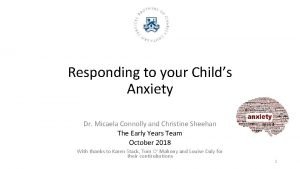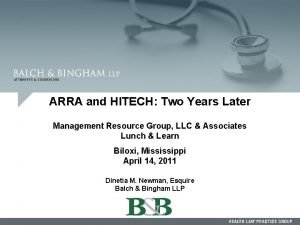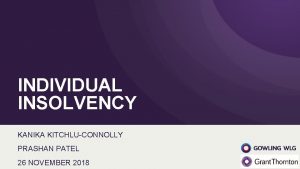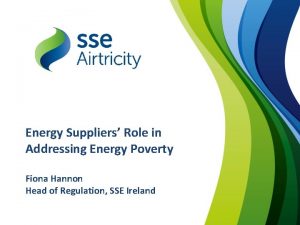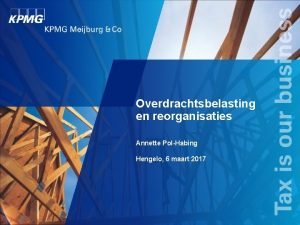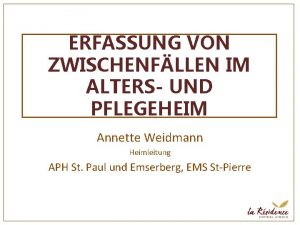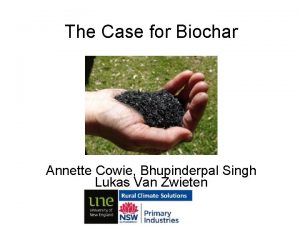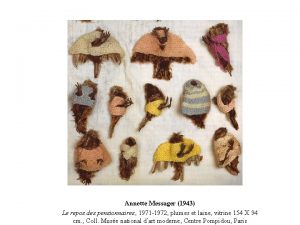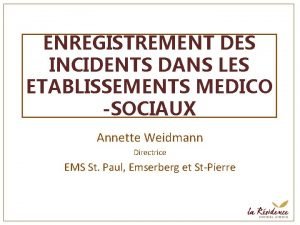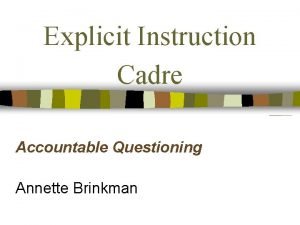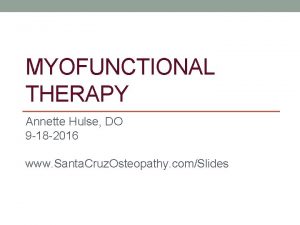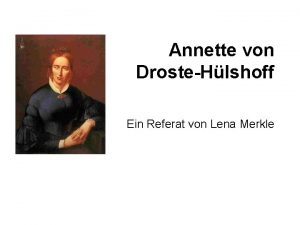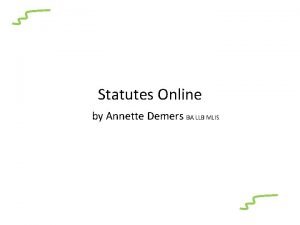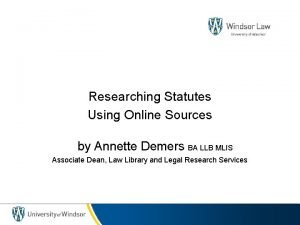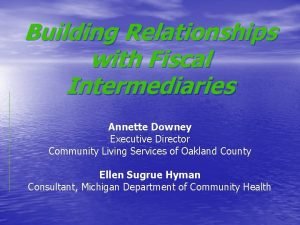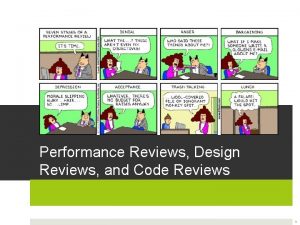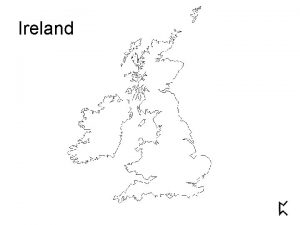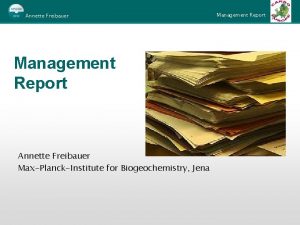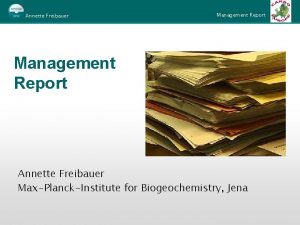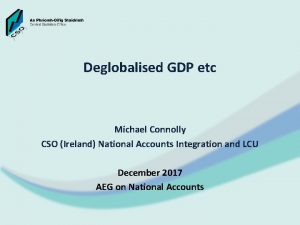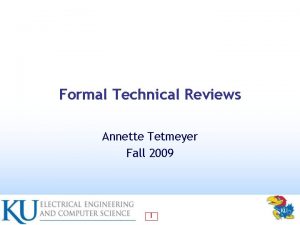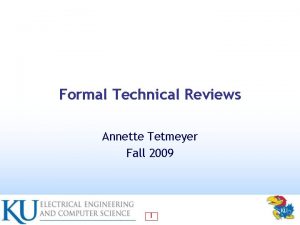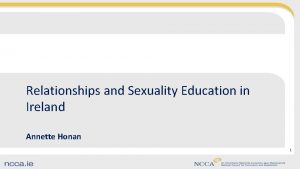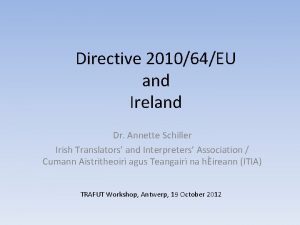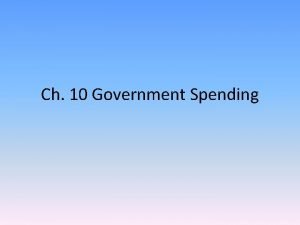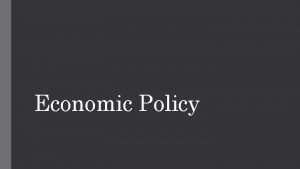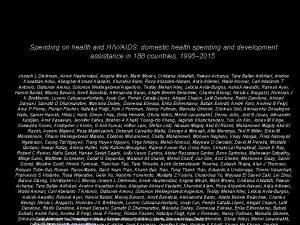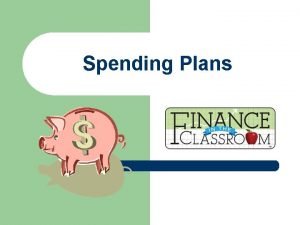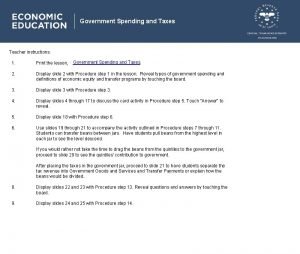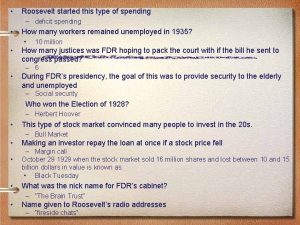Spending Reviews in Ireland Annette Connolly Department of

























- Slides: 25

Spending Reviews in Ireland Annette Connolly Department of Public Expenditure and Reform 1

Background Spending reviews have played an important role in Ireland’s efforts to restore expenditure policy to a more sustainable footing. Primary focus – reducing expenditure to meet fiscal targets at a time of unprecedented fiscal consolidation. Three comprehensive reviews of expenditure conducted since 2009.

The Irish Public Service: Overview

Context of Spending Reviews Goal: From deficit reduction increasing fiscal space

Billions Collapse in Economic Output post-2007 € 190 € 180 € 170 € 160 € 150 € 140 € 130 € 120 2006 2007 2008 2009 (Real) Gross Domestic Product 2010 2011 2012 (Real) Gross National Product 2013

Billions Impacts on the Public Finances € 50 € 45 € 40 € 35 € 30 € 25 € 20 € 15 € 10 € 5 € 0 2006 2007 2008 2009 2010 Exchequer Revenue from. . . 2011 2012 2013

Widening General Government Deficit 4. 0% 2. 90% 2. 0% 0. 10% 0. 0% 2006 2007 2008 2009 2010 2011 2012 2013 2014 2015 -0. 90% -2. 30% -4. 0% -3. 80% -6. 80% -8. 0% -7. 40% -8. 20% -9. 10% -10. 70% -12. 0% 2016 (Estimate) -11. 40%

Breakdown of Expenditure by Department ¡ Three big spending Departments generally spend 7580% of total expenditure. Total Expenditure 2015 € 54. 6 billion Others 22% Social Protection 37% Education 17% Total Expenditure 2016 € 56. 1 billion Others 24% Social Protection 35% Education 16% Health 24% Total Expenditure 2017 € 58 billion Others 24% Social Protection 34% Education 16% Health 25% 8 Health 25%

Special Group – “Mc. Carthy Report” (2009) ¡ ¡ Preceded by a round of administrative efficiency measures in 2008 – still an urgent need to find savings Objective: Review the scope for reducing or discontinuing Expenditure Programmes with a view to eliminating the current budget deficit by 2011. 6 month timeframe – no explicit savings target identified External Membership – Six Members of the Group chaired by Mr Colm Mc. Carthy, School of Economics University college Dublin.

Methodology ¡ ¡ ¡ Each Department was invited to meet the Group and to submit an evaluation paper in advance – structured template provided in advance. In parallel with this process, the Department of Finance Vote sections (which monitored spending in the various Departments) prepared independently their own evaluation papers with recommendations and options for expenditure and staff reductions. Both sets of evaluation papers were considered in advance of meeting the management teams of each Department.

Outcome ¡ ¡ ¡ The Special Group identified potential expenditure savings of € 5. 3 bn in a full year, with associated reductions of over 17, 300 in public service numbers. The breakdown of savings, amounted to 9. 3% of relevant expenditure Most but not all of the savings identified were potentially deliverable in 2010, as some options would deliver full savings over a number of years.

A New Direction ¡ The Department of Public Expenditure and Reform (DPER) was established in 2011 ¡ The new Department was comprised of the Sectoral Policy and Public Service Management Divisions of the Department of Finance with units assigned from the Public Service Modernisation Division of the Department of the Taoiseach. ¡ Since 2011 DPER has driven and had oversight of the Comprehensive Reviews of Expenditure.

Comprehensive Reviews of Expenditure ¡ Conducted in 2011 and 2014 ¡ Planned reviews undertaken on a periodic basis ¡ Integrated in the reformed expenditure framework ¡ ¡ Final decisions made by Government and presented to the Oireachtas as part of the annual budget process. The next Comprehensive Review of Expenditure is due to take place in 2017.

Comprehensive Review of Expenditure (2011) ¡ Objective l l l ¡ ¡ re-align spending with the revised Programme for Government priorities; meet overall fiscal objectives; and explore new and innovative ways of delivering Government policy in a reformed Public Sector. Result of analysis to be used to develop multi-annual budget plans with a 3 year time horizon. Internally led – high-level steering group chaired by the Department of Public Expenditure and Reform

Comprehensive Review of Expenditure (2011) ¡ ¡ Departments had responsibility for evaluating every budget programme under their responsibility. Templates were provided by DPER – three value for money tests: l l l ¡ Purpose of the Programme Effectiveness Efficiency Submissions were invited from members of the public and were passed on to the relevant Department for consideration.

Comprehensive Review of Expenditure (2014) ¡ ¡ ¡ First Spending Review to ask Departments to identify a certain volume of savings – 5% of the expenditure ceilings for 2015. Similar methodology to the 2011 CRE with the addition of a Working Group of Senior Officials to support the High Level Steering Group. The Working Group managed the day-to-day operation of the CRE process allowing the Steering Group to have an overview of how the CRE was progressing.

Departmental expenditure growth: Three-year intervals Departmental expenditure growth: two-year intervals 2014 -2017 2011 -2014 2008 -2011 9% -6% -8% 2005 -2008 38% 2002 -2005 26% 1999 -2002 -20% 57% -10% 0% 10% 20% 30% 40% 50% 60% 70%

Lessons Learned (1)– Be Prepared to Invest ¡ ¡ ¡ Spending Evaluations are resource intensive. Important to be aware of the necessary commitment and time investment required at the outset Crucial that staff have the necessary expertise – can’t be driven entirely by the central expenditure function, Departments need to have the internal capacity to conduct the necessary analysis.

Lessons Learned (2) – Leadership and Ownership ¡ There must be buy-in at a political level and among senior management. ¡ External leadership was important at outset l l Special Group provided an external viewpoint External Recommendations - helped implementation ¡ After initial stage, important that ownership of the process shifted back to public service – embed the culture of evaluation ¡ Challenge going forward is sharing ownership with line Departments – shared responsibility

Lessons Learned (3) – Central Budget Office Plays a Key Role ¡ ¡ ¡ Key role in designing the spending review framework and advising political level on selection of parameters Provide templates and guidance to Departments Clearly designated ‘command centre’ is needed to co-ordinate the review and take on a challenge role where necessary. Vital that the Central Budget Office has a cohort of staff with not just financial or public knowledge but also relevant policy experience. Crucial that evaluation and performance information is available and relevant

Lessons Learned (4) – Structure and Goals ¡ ¡ At the outset it is important to be clear about what it is hoped the spending review will achieve. The target and focus of the spending review should be specifically articulated. o A focus on creating appropriate templates and a consistent methodology at the beginning of the process will pay dividends.

Lessons Learned (5) - Greater Incorporation of Performance Information ¡ Performance indicators by themselves are insufficient to assess whether a specific policy is effective. ¡ Need to ensure that the budget preparation process is designed so that information from evaluations is available at the right time in the right format in order to assess new proposals and ongoing programmes.

Continued…Lessons Learned (5) - Greater Incorporation of Performance Information ¡ It is a challenge to ensure that performance information becomes embedded into resource allocation and decision making. ¡ The spending review process plays a key role in developing the culture of evaluation by demonstrating the importance of this information in creating fiscal space for new policies within the budget process. 23

Lessons Learned (6) Continued Development of an Evaluation Culture ¡ DPER has a central role in continuing to promote a culture of output and evaluation information l l l ¡ ¡ Public Spending Code review Performance Reports Expanded IGEES Evaluation/ analysis for spending review are a subset of overall evaluation/analysis Focus on impact and implementation of potential policy decisions

QUESTIONS?
 Fundamentals of web development randy connolly ppt
Fundamentals of web development randy connolly ppt Connolly & hickey historical architects
Connolly & hickey historical architects Andrew connolly exeter
Andrew connolly exeter Sucheta connolly md
Sucheta connolly md Micaela connolly
Micaela connolly Connolly recovery audit
Connolly recovery audit Prashan patel grant thornton
Prashan patel grant thornton Connolly lodge buckingham street
Connolly lodge buckingham street Annette pol
Annette pol Annette cosway
Annette cosway Annette buchanan
Annette buchanan Aph emserberg
Aph emserberg Annette cowie
Annette cowie Annette brinkman
Annette brinkman Les pensionnaires annette messager
Les pensionnaires annette messager Annette weidmann
Annette weidmann Santa cruz sleep apnea devices
Santa cruz sleep apnea devices Annette westin
Annette westin Annette brinkman
Annette brinkman Annette hulse
Annette hulse Annette von droste hülshoff referat
Annette von droste hülshoff referat Annette demers
Annette demers Annette gregg
Annette gregg Annette demers
Annette demers Annette downey
Annette downey Digi notar
Digi notar




